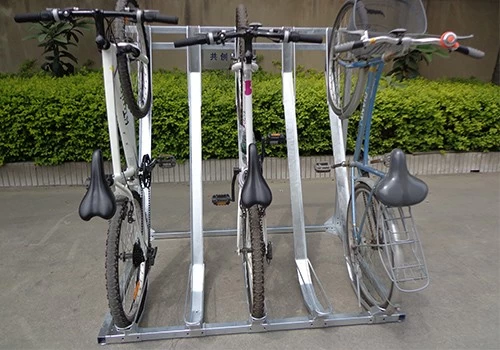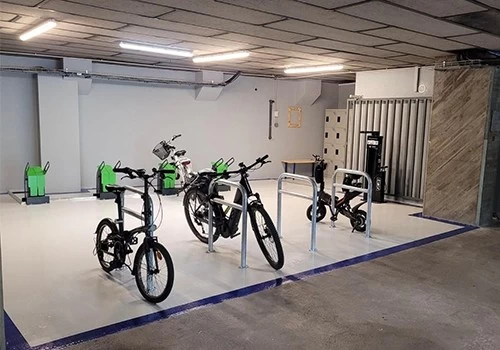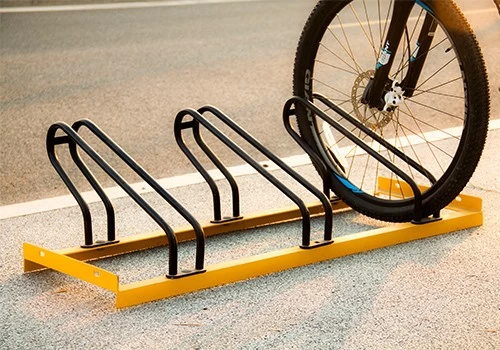Specifications
Model Number : PV-SC-001
Type: Bike parking and storage
Color:Yellow,Black,Green,Red,or Customized.
Style : both indoors and outside
Material : carbon steel
Loading: According to customer need
Size :195*23.2*75cm,200.55*23.2*75cm,or Customized.
Finish: hot-galvanized
Specifications
Model Number : PV-0081-01
Type: Bike parking and storage
Color:silver
Style : both indoors and outside
Material : carbon steel
Loading: According to customer need
Size :Height 1463mm, Depth 1114mm
Finish: hot-galvanized
Model Number : PV-0081-01
Type: Bike parking and storage
Color:Black
Style : both indoors and outside
Material : carbon steel
Loading: 2-10 bikes (According to customer need)
Size :Height 1463mm, Depth 1114mm
Finish: hot-galvanized
Model No.: PV-H1
Size: w605*D400*H330mm
Specification: Round tube:¢16*1.2mm
Finish: Power coated
Net Weight: 1.6 kgs
Packing size:6pcs/ctn
MOQ: 100pcs
Model Number : PV-0024-01
Material : carbon steel/stainless steel
Loading: according customer space size,we can design according the size
Size : W1977*D1130(depend on your parking space)*H2500mm
Finish: Powder coated ,hot-galvanized/electric polish
Packing size :2000*2000*2500mm(40 parking space )
Powder coated ,hot-galvanized/electric polish
Product number:PV-0046-01
Material:carbon steel
Specification:10.2*59*28CM or Customized.
MOQ:100PCS
Port:Shanghai
Trademark:PV
Model Number : PV-0081-01
Type: Outdoor Bike Parking Rack
Style : both indoors and outside
Material : carbon steel
Loading: 2-10 bikes (According to customer need)
Size :170.5*116*148CM
Finish: hot-galvanized
Model Number : PV-0055-01
Type: compact flat pack /slot
Color:black / silver /yellow/optional
Style :Outdoor/indoor
Material : carbon steel/ stainless steel
Capacity : park 6 bikes
Size : L1400*W1054*H840mm
Net weight :38KG
Finish: powder coating / hot galvanized /elctropolishing
Packing size :1490*860*160mm 1pcs/ctn
Product Name: Multi-Capacity Horizontal Two Tier Bike Parking Rack
Material: Carbon Steel
Finish: Powder coated
Post: 80mm * 80mm thickness: 3mm
Steel plate: thickness: 2mm
Dimension: 1325*1890*1830mm
Weight: 370 kg/set
Model: PV-0067-01
Material: stainless steel 304
Pipe: 50 mm* 2.5 mm
Size: 900*700 mm(L*W)
Surface treatment: polishing

In an era marked by growing concerns over climate change, urban congestion, and public health, cities and communities worldwide are reimagining transportation systems. Among the most promising solutions is the rise of active transportation—modes of travel that rely on human energy, such as walking and cycling. Bicycling, in particular, has emerged as a sustainable, accessible, and cost-effective alternative to motorized transport. Yet, for cycling to truly thrive, one often-overlooked infrastructure element is critical: bicycle parking racks. These humble structures play a pivotal role in removing barriers to cycling, fostering community engagement, and building healthier, more connected neighborhoods. This article explores how well-designed, strategically placed bicycle parking racks serve as catalysts for active transportation and community development.
Active transportation refers to any form of human-powered mobility, including walking, cycling, skateboarding, and using wheelchairs. Unlike cars, buses, or trains, these modes produce zero emissions, reduce traffic congestion, and promote physical activity. Cycling, in particular, offers a unique blend of efficiency and accessibility: it covers longer distances than walking, requires less physical exertion than running, and can easily integrate into daily routines—whether commuting to work, running errands, or traveling to school.
The benefits of active transportation are far-reaching:
Yet, for all these benefits to be realized, cycling must be convenient and safe. This is where bicycle parking racks come into play.

Imagine planning a bike ride to the grocery store, only to arrive and find no secure place to lock your bicycle. Or commuting to work, but worrying that your bike will be stolen while you’re in the office. These scenarios are all too common—and they deter people from cycling. Bicycle parking racks address these barriers by providing a simple, essential service: a safe, accessible place to store a bike.
Research consistently shows that the availability of secure parking is one of the top factors influencing whether people choose to cycle. A study by the National Association of City Transportation Officials (NACTO) found that cities with robust bicycle parking infrastructure saw a 20–30% increase in cycling rates compared to those without. Why? Because parking racks solve two critical concerns:
For example, in Portland, Oregon, a city renowned for its cycling culture, the installation of 1,000 new bike racks in commercial districts between 2010 and 2015 correlated with a 27% increase in cycling trips to local businesses, as reported by the Portland Bureau of Transportation. Business owners noted that cyclists stayed longer and spent more than drivers, highlighting how parking racks can drive economic activity.
Beyond promoting active transportation, bicycle parking racks play a subtle but powerful role in building stronger, more connected communities. They do this by transforming public spaces, encouraging social interaction, and fostering a sense of shared responsibility.
Well-designed bike racks are more than functional—they can enhance the aesthetic appeal of public spaces. Modern racks come in a variety of styles, from sleek, minimalist designs to artistic, community-inspired installations. For instance, in Copenhagen, a city with some of the world’s highest cycling rates, bike racks are often integrated into street furniture, doubling as benches or planters. This not only saves space but also makes streets more inviting for pedestrians and cyclists alike.
In smaller communities, custom bike racks can reflect local identity. A coastal town might install racks shaped like waves; a university campus could feature racks with the school’s logo. These design choices turn utilitarian structures into points of pride, sparking conversations and reinforcing community spirit.
Cycling is inherently social. When people park their bikes together, they’re more likely to strike up conversations—whether discussing the best cycling routes, sharing tips on bike maintenance, or simply chatting about the day. This casual interaction builds social capital, the “glue” that holds communities together.
Schools provide a prime example. Installing bike racks near school entrances encourages students to cycle, but it also creates a hub where kids gather before and after classes. Teachers and parents report that students who cycle to school often form stronger friendships and develop a greater sense of responsibility—skills that translate to better community engagement later in life.
Active transportation should be accessible to everyone, regardless of income, age, or ability. Bicycle parking racks play a key role in promoting equity by making cycling a viable option for low-income communities, where car ownership may be prohibitively expensive.
In underserved neighborhoods, installing affordable, durable bike racks near public transit stops, grocery stores, and healthcare clinics can bridge transportation gaps. For example, in Chicago’s South Side, a community-led initiative to install bike racks near bus stations and food deserts (areas without easy access to fresh food) increased cycling among residents by 35% over two years, according to a 2023 study by the Active Transportation Alliance. This not only improved access to essential services but also reduced transportation costs for families living on tight budgets.
Not all bike racks are created equal. The best parking solutions are tailored to the unique needs of a community, considering factors like usage patterns, space constraints, and aesthetic preferences. Here’s how different settings benefit from specialized racks:
In busy downtown areas, space is limited, and foot traffic is high. Racks here need to be compact, durable, and easy to use. Wall-mounted or vertical racks are ideal, as they take up less sidewalk space while still accommodating multiple bikes. Additionally, racks placed near storefronts—rather than hidden in alleys—increase visibility, deterring theft and making cycling more convenient for shoppers.
For example, in New York City’s Brooklyn Heights neighborhood, the installation of “staple-style” racks (a classic, space-efficient design) outside cafes and boutiques led to a 40% increase in cyclists stopping to shop, according to a 2022 survey by the Brooklyn Chamber of Commerce.
Schools require racks that can handle high volumes of bikes—especially during peak hours like drop-off and pick-up. Racks should be placed in well-lit, visible areas to ensure safety, and they should be easy for children and teenagers to use. Grid-style racks, which can hold multiple bikes in a small footprint, are popular in these settings.
At the University of Washington, Seattle, the campus has over 10,000 bike parking spots, including covered racks and secure bike lockers. This infrastructure supports the fact that 28% of students and 12% of faculty commute by bike—well above the national average—creating a culture of sustainability that extends beyond campus borders.
In neighborhoods, bike racks foster a sense of community by making cycling a convenient option for short trips. Racks near parks, community centers, and local shops encourage residents to leave their cars at home. For apartment buildings, secure, covered racks (or even bike rooms) are essential, as they protect bikes from the elements and reduce clutter in hallways.
In Portland’s Pearl District, a mixed-use neighborhood, developers incorporated bike racks into every residential building and public park. As a result, 62% of residents report cycling at least three times a week, compared to 31% citywide, according to the Portland Bureau of Planning and Sustainability.
Bike racks at bus, train, and subway stations enable “multi-modal” commuting—cycling to a transit stop, then taking public transit for longer distances. These racks need to be highly secure and capable of handling large numbers of bikes during rush hour. Some cities, like Amsterdam, have gone a step further, installing automated bike parking garages at major transit hubs, but even basic, well-placed racks can make a significant difference.
In San Francisco, the Bay Area Rapid Transit (BART) system added 5,000 bike rack spaces at stations between 2018 and 2023. The result? A 55% increase in cyclists combining biking with BART, reducing both car traffic to stations and parking lot congestion.

As cycling grows in popularity, so too does innovation in bike rack design. Modern racks are no longer just metal bars—they’re engineered to balance functionality, durability, and aesthetics.
Sustainability is a key consideration in rack design. Many manufacturers now use recycled steel or aluminum, reducing the environmental impact of production. Weather-resistant coatings, like powder coating, ensure racks withstand rain, snow, and extreme temperatures, extending their lifespan and reducing maintenance costs.
Cities and communities are increasingly using bike racks as a form of public art. For example, in Austin, Texas, local artists designed racks shaped like musical notes, reflecting the city’s reputation as the “Live Music Capital of the World.” In Boston, some racks feature historical motifs, paying homage to the city’s colonial past. These designs not only serve a practical purpose but also enhance the visual appeal of streets, making them more welcoming to residents and visitors.
The rise of smart cities has led to innovative “connected” bike racks. Some models include solar-powered LED lights for visibility at night, while others have sensors that alert city officials when racks are full, helping optimize placement of additional infrastructure. In Copenhagen, a pilot program uses app-enabled racks that allow cyclists to reserve spots in advance, reducing frustration and encouraging more people to cycle.
While the benefits of bike racks are clear, their widespread adoption requires intentional policy and planning. Cities and communities that prioritize active transportation often include bike parking requirements in zoning laws, building codes, and urban development plans.
For example:
These policies send a clear message: cycling is a valued mode of transportation, and infrastructure to support it is non-negotiable. For bicycle parking rack manufacturers, this creates opportunities to partner with cities, developers, and community organizations to deliver solutions that meet local needs.
As communities continue to embrace active transportation, the role of bicycle parking racks will only grow. Here are three trends shaping the future of bike parking:
Bicycle parking racks may seem like small pieces of infrastructure, but their impact is profound. They remove barriers to cycling, making active transportation a viable option for more people. They transform public spaces, turning streets into vibrant, community-focused areas. They support equity, ensuring that cycling is accessible to all, regardless of income or background.
For communities looking to reduce their carbon footprint, improve public health, and build stronger social connections, investing in quality bicycle parking is a simple, cost-effective solution. And for manufacturers, it’s an opportunity to be part of a movement—one that’s reimagining transportation, one rack at a time.As more cities and towns recognize the value of bicycle parking, we can look forward to a future where cycling isn’t just a hobby, but a way of life—one that brings people together, keeps communities healthy, and helps protect our planet.